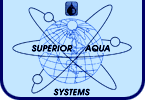|
||||||||||||||||||||||||||||||||||||
 |
||||||||||||||||||||||||||||||||||||
STUDIES IN IONIZATION DISINFECTION
Abstract
|
TITLE:
|
Microbiological Evaluation of Copper: Silver Disinfection Units |
|
AUTHORS:
|
Kutz SM, Landeen LK, Yahya MT, and Gerba CP |
|
PUBLICATION
REF:
|
Proceedings of the Fourth Conference on Progress in Clinical Disinfection. State University of New York, Bighamton, New York, April 11-13, 1988 |
PURPOSE
OF STUDY:
Although
chlorination is the traditional method of disinfecting swimming pools,
hot tubs, and cooling towers to prevent outbreaks of illness due to pathogenic
bacteria, viruses, and protozoa, high levels of chlorine can cause eye
and skin irritation was well giving rise to a noticeable chlorine odor.
The authors evaluated electrolytically generated copper: silver ions alone
and in combination with low levels of free chlorine as an alternative
method of reducing the bacterial population in water.
MATERIALS
AND METHODS:
The
test medium was local well water which was subjected to chemical analysis,
filtering, and pH stabilization and used at room temperature. Suspensions
of the following organisms were prepared: Escherichia coli, Legionella
pneumophila, Staphylococcus aureus, Pseudomonas aeruginosa,
Salmonella TYPHII, Klebsiella terrigena, and Streptococcus
faecalls. Approximately 1 ml of the selected bacterial suspension
was added to 99 ml of test medium containing (1) copper: silver
ions in a concentration of 400 ug/liter copper to 40 ug/liter silver,
(2) free chlorine (0.2 mg/liter) alone, or (3) a combination
of copper: silver ions and free chlorine (quantities as above). Cultures
were incubated and the bacterial colonies enumerated, after which statistical
analysis were performed.
RESULTS:
The bacteria tested were inactivated more rapidly in a solution
in which electrolytically generated copper and silver ions were added
to low levels of chlorine than where either method was used separately.
Some organisms were more resistant to treatment than others. In the experiments
with Salmonella typehi and Klebsiella terrigena no viable
cells were recovered after 30 seconds of exposure to either chlorine alone
or to the combined regimen, indicating equal effectiveness when resistance
to disinfection is low. On the other hand, Legionella pneumophilia
titers decreased more than 5 log 10 values after 7 minutes of exposure
to free chlorine (0.2 mg/liters) alone for the same length of time. Similarly,
E. coli numbers were reduced by 4.2 log 10 by the combination regimen
but by less than 3 log 10 after extended exposure to the copper: silver method without
chlorine.
CONCLUSIONS:
The use of electrolytically generated copper and silver ions
in combination with low levels of free chlorine proved an effective method
of killing a wide range of pathogenic bacteria under controlled test conditions.
Such bacteria are of potential concern in swimming pools and cooling towers.